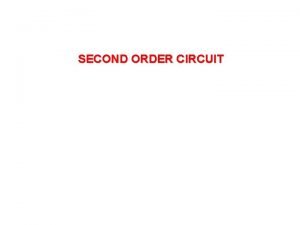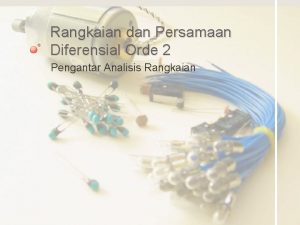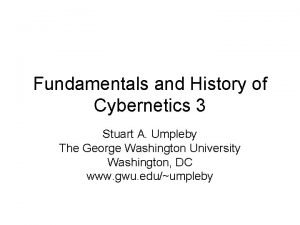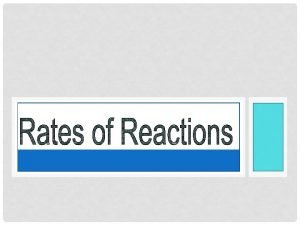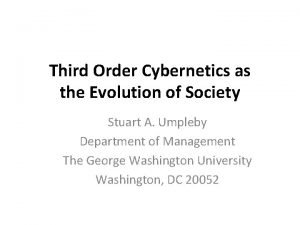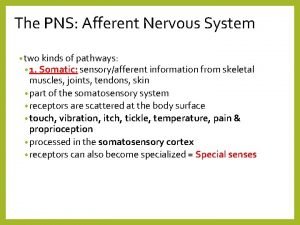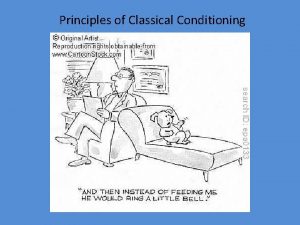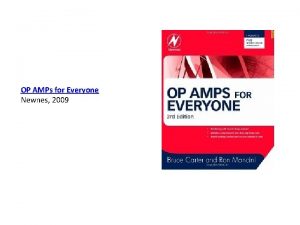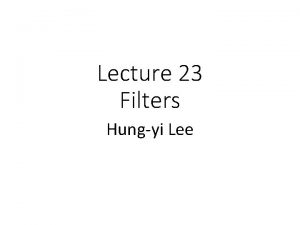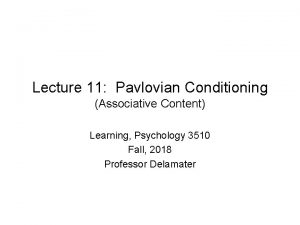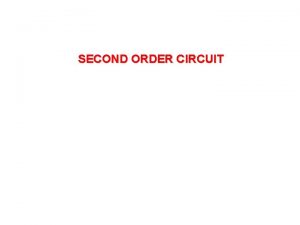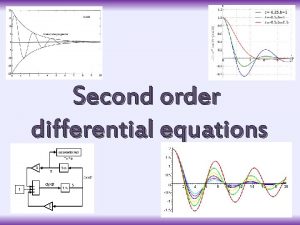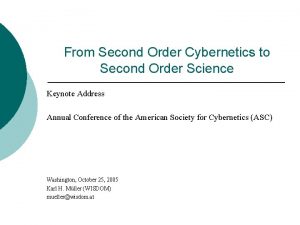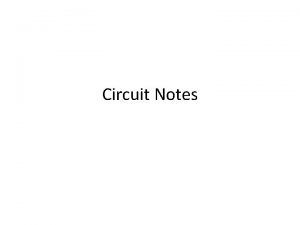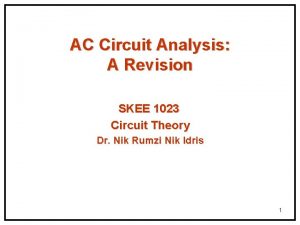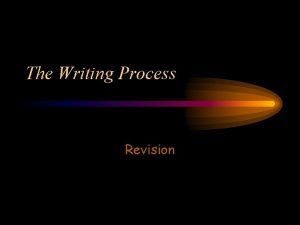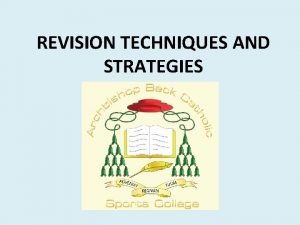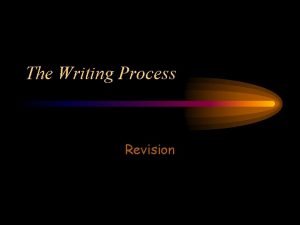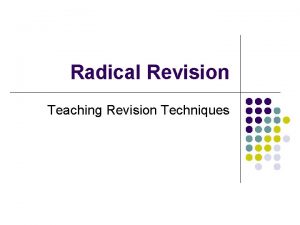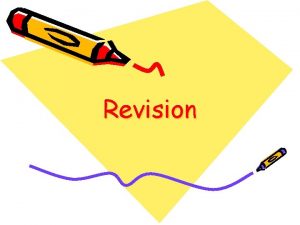SECOND ORDER CIRCUIT SECOND ORDER CIRCUIT Revision of






















- Slides: 22

SECOND ORDER CIRCUIT

SECOND ORDER CIRCUIT • Revision of 1 st order circuit • Second order circuit • Natural response (source-free) • Forced response

Revision of 1 st order circuit NATURAL RESPONSE (SOURCE-FREE) + v. R i. R R Solution: i. C C + v. C - initial energy in capacitor - i. e. v. C(0) = Vo KCL Solving this first order differential equation gives:

Revision of 1 st order circuit R Vsu(t) + Solution: FORCED RESPONSE + v. C C - no initial energy in capacitor - i. e. v. C(0) = 0 KCL Solving this first order differential equation gives:

Revision of 1 st order circuit COMPLETE RESPONSE Complete response = natural response + forced response v(t) = vn(t) + vf(t) Complete response = Steady state response + transient response v(t) = vss(t) + vt(t)

Revision of 1 st order circuit COMPLETE RESPONSE In general, this can be written as: - can be applied to voltage or current - x(0) : initial value - x( ) : steady state value For the 2 nd order circuit, we are going to adopt the same approach

Before we begin …. . To successfully solve 2 nd order equation, need to know how to get the initial condition and final values CORRECTLY INCORRECT initial conditions /final values will result in a wrong solution In 1 st order circuit • need to find initial value of inductor current (RL circuit) OR capacitor voltage (RC circuit): i. L(0) or v. C(0) • Need to find final value of inductor current OR capacitor voltage: i. L(∞) or v. C(∞) In 2 nd order circuit • need to find initial values of i. L and/or v. C : i. L(0) or v. C(0) • Need to find final values of inductor current and/or capacitor voltage: i. L(∞) , v. C(∞) • Need to find the initial values of first derivative of i. L or v. C : di. L(0)/dt dv. C(0)/dt Section 8. 2 of Alexander/Sadiku

Finding initial and final values Example 8. 1 Switch closed for a long time and open at t=0. Find: i(0+), v(0+), di(0+)/dt, dv(0+)/dt, i(∞), v(∞)

Finding initial and final values PP 8. 2 Find: i. L(0+), v. C(0+), v. R(0+) di. L(0+)/dt, dv. C(0+)/dt, dv. R(0+)/dt, i. L(∞), v. C(∞), v. R(∞)

Second order circuit Natural Response of Series RLC Circuit (Source-Free Series RLC Circuit) R L We want to solve for i(t). C Applying KVL, i Differentiate once, This is a second order differential equation with constant coefficients

Second order circuit Assuming Since cannot become zero, This is known as the CHARACTERISTIC EQUATION of the diff. equation

Second order circuit Solving for s, Which can also be written as where s 1, s 2 – known as natural frequencies (nepers/s) – known as neper frequency, o – known as resonant frequency

Second order circuit A 1 and A 2 are determined from initial conditions Case 1 Overdamped solution Case 2 Critically damped solution Case 3 Underdamped solution

Second order circuit Case 1 Overdamped response Roots to the characteristic equation are real and negative A 1 and A 2 are determined from initial conditions: (i) At t = 0, (ii) At t = 0,

Second order circuit Case 1 Overdamped response 100 0. 05 H + vc 0. 5 m. F Initial condition vc(0) =100 V

Second order circuit Case 2 Critically damped response A 3 is determined from 2 initial conditions: NOT POSSIBLE solution should be in different form: A 1 and A 2 are determined from initial conditions: (i) At t = 0, (ii) At t = 0,

Second order circuit Case 2 Critically damped response 20 0. 05 H + vc 0. 5 m. F Initial condition vc(0) =100 V

Second order circuit Case 3 Underdamped response Roots to the characteristic equation are complex - known as damped natural frequency

Second order circuit Case 3 Underdamped response Using Euler’s identity: ej = cos + jsin where

Second order circuit Case 3 Underdamped response (i) At t = 0, (ii) At t = 0,

Second order circuit Case 3 Underdamped response 10 0. 05 H + vc 0. 5 m. F Initial condition vc(0) =100 V

Second order circuit Underdamped, overdamped and critically damped responses
 Active revision vs passive revision
Active revision vs passive revision Second order circuit
Second order circuit Rangkaian orde 2
Rangkaian orde 2 Second order change
Second order change First order cybernetics and second order cybernetics
First order cybernetics and second order cybernetics 1st order 2nd order 3rd order neurons
1st order 2nd order 3rd order neurons 186 282 miles per second into meters per second
186 282 miles per second into meters per second In series vs in parallel
In series vs in parallel Types of circuit
Types of circuit Circuit construction kit
Circuit construction kit Series vs parallel circut
Series vs parallel circut Complete and incomplete circuits with inference
Complete and incomplete circuits with inference Short circuit series
Short circuit series Static vs current electricity venn diagram
Static vs current electricity venn diagram Pulmonary circuit and systemic circuit
Pulmonary circuit and systemic circuit Advantages of parallel circuit over series circuit
Advantages of parallel circuit over series circuit Rate law for zero order
Rate law for zero order Second order cybernetics family therapy
Second order cybernetics family therapy Type 1 cutaneous mechanoreceptors
Type 1 cutaneous mechanoreceptors Order of classical conditioning
Order of classical conditioning Second order band pass filter transfer function
Second order band pass filter transfer function Second order band pass filter transfer function
Second order band pass filter transfer function Second-order conditioning examples
Second-order conditioning examples

